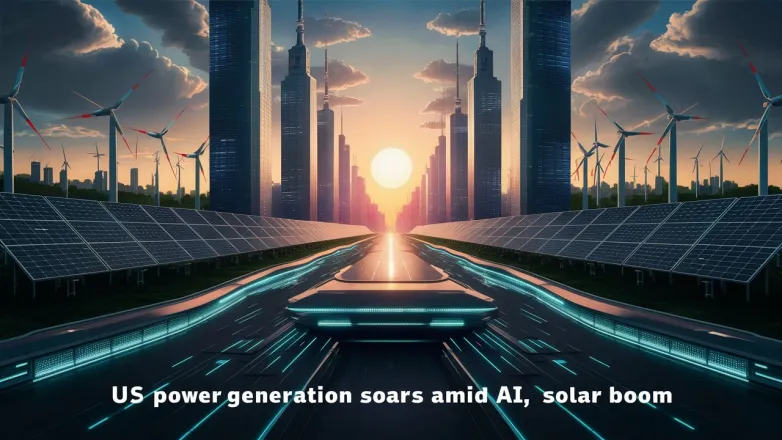US Power Generation Soars Amid AI, Solar Boom
- Power capacity surges 20.2 GW in 2024! Demand from AI and data centers fuels solar growth, signaling a historic shift towards greener energy solutions.

U.S. power developers increased generation capacity by 20.2 gigawatts in the first half of 2024, the largest rise since 2003, driven by growing electricity demand from data centers and artificial intelligence. The Energy Information Agency (EIA) reported that this 21% increase over the same period in 2023 is expected to more than double to 42.6 gigawatts by year-end. Solar power is set to lead these additions, potentially reaching a record 37 gigawatts for the year.
The surge in power demand has also slowed the retirement of coal- and gas-fired plants, with retirements falling by 45% in the first half of 2024 compared to the previous year. The bulk of new capacity is expected to come from carbon-free sources, including solar and battery storage, as the U.S. moves towards greater electrification.
What Factors Drove the Record Increase in U.S. Power Generation Capacity in 2024?
Factors Driving the Record Increase in U.S. Power Generation Capacity in 2024
- Rising Electricity Demand:
- An unprecedented surge in electricity demand, particularly from data centers and artificial intelligence (AI) operations, necessitating increased power generation capacity.
- Increasing reliance on digital services and cloud computing contributes to sustained and rising electricity consumption.
- Renewable Energy Investment: - Accelerated investment in renewable energy projects, particularly solar, supported by federal and state incentives, tax credits, and subsidies.
- The declining costs of solar technology and energy storage solutions make renewable projects more economically feasible for developers and investors.
- Technological Advancements: - Innovations in energy production and storage technology provide more efficient and scalable solutions, enabling quicker deployment of renewable energy projects.
- Advances in battery storage technologies enhance grid reliability and energy supply management, allowing for better integration of variable renewable energy sources.
- Policy and Regulatory Support: - Strong federal and state policies favoring renewable energy and reducing greenhouse gas emissions, boosting investor confidence in the clean energy sector.
- Additional regulations and commitments to achieve carbon neutrality have spurred many utilities to seek renewable energy acquisitions actively.
- Corporate Commitments to Sustainability: - Increased commitments from corporations to achieve sustainability goals and reduce their carbon footprint drive demand for clean energy sources.
- Many businesses are entering power purchase agreements (PPAs) with renewable energy developers, further propelling market growth.
- Economic Recovery and Infrastructure Spending: - Post-pandemic economic recovery has led to increased federal and state infrastructure spending, including investments in renewable energy generation capacity.
- The Infrastructure Investment and Jobs Act has prioritized clean energy projects, stimulating growth and development in this sector.
- Infrastructure Interconnectivity Improvements: - Enhanced transmission infrastructure and grid upgrades facilitate the integration of new renewable energy sources, permitting greater capacity expansion.
- Smart grid technologies allow for improved demand response and energy distribution, further supporting increased generation capabilities.
- Delayed Plant Retirements: - A significant slowdown in the retirement of older coal and gas-fired plants allows for greater capacity utilization while new renewable projects come online.
- The demand for continuous power supply amid increasing electricity usage results in a reconsideration of decommissioning timelines for fossil fuel plants.
- Market Volatility and Energy Prices: - Fluctuating energy prices, particularly in fossil fuels, have shifted more attention to renewables as a stable and often cheaper alternative in the long run.
- The urgency to transition to more stable, sustainable, and non-volatile energy sources reinforces the growth of renewable capacity.
- Public Awareness and Climate Action: - Growing public concern over climate change and the environmental impacts of fossil fuels drives consumer preferences toward renewable energy solutions.
- Increasing awareness and activism around climate issues encourage both utilities and governments to prioritize investments in clean energy.
Also read

